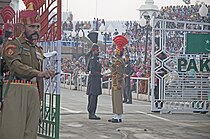| Northwestern South Asia | |
|---|---|
 A handshake between soldiers at the India–Pakistan border. | |
| Countries | |
| Time zones | UTC+05:30; UTC+05:45; UTC+06:00 |
| Calling codes | |
| Religions | Hinduism, Islam, Christianity, Buddhism, Irreligion, Sikhism |
| Ethnic groups | Indo-Aryan, Iranian, Tibeto-Burmese |
Northwestern South Asia is a geographical area in South Asia. It includes the modern-day Afghanistan, Pakistan, north-western India, and the Tibet Autonomous Region of China.[1]
Northwestern South Asia is the site of many of the first civilisations of the world, such as the Indus Valley Civilisation.[2][3] It was historically the most-conquered region of South Asia because it is the first region that invading armies coming from the west had to cross to enter the Indian subcontinent;[4] notable conquests include the Indian campaign of Alexander the Great in the fourth century BCE and several Muslim invasions from the 8th century CE to the 18th century.[5][6] Because of these many invasions, Northwestern South Asia has significant influences from various sources outside of South Asia, mainly from the Muslim world. Prior to Islamic influence, the region was largely Hindu and Buddhist, and was home to hotbeds of Buddhist activity such as Gandhara.[7]
- ^ Kachmar, Oleh (18 June 2020). "China Joins India and Pakistan in the Kashmir Battlespace". New Lines Institute. Retrieved 5 October 2023.
- ^ "Decline of the Indus River Valley Civilization (c. 3300-1300 BCE)". Climate in Arts and History. Retrieved 5 October 2023.
- ^ Thornton, Christopher P.; Cable, Charlotte (2016), Introduction: Between Two Civilizations, University of Pennsylvania, Museum of Archaeology and Anthropology, ISBN 978-1-934536-06-3, retrieved 5 October 2023
- ^ South Asia’s Geography of Conflict https://www.files.ethz.ch/ Robert D. Kaplan
- ^ Thornton, Christopher P.; Cable, Charlotte (2016), Introduction: Between Two Civilizations, University of Pennsylvania, Museum of Archaeology and Anthropology, ISBN 978-1-934536-06-3, retrieved 5 October 2023
- ^ Anjum, Tanvir (2007). "The Emergence of Muslim Rule in India: Some Historical Disconnects and Missing Links". Islamic Studies. 46 (2): 217–240. ISSN 0578-8072. JSTOR 20839068.
- ^ Neelis, Jason (2010). Early Buddhist Transmission and Trade Networks: Mobility and Exchange within and beyond the Northwestern Borderlands of South Asia. Brill. ISBN 978-90-04-19458-8.
